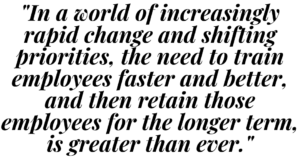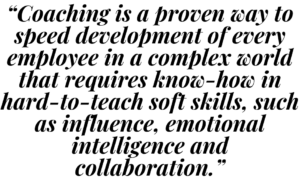Regardless of which group they were in (and unfortunately it was often perceived as being the latter), executive coaching was for those at the top or on their way. Middle management and below were simply not considered worth the time or expense of engaging with a coach. 
But those perceptions are changing, and changing for the better with the trend towards democratization of leadership coaching. Now the benefits derived from having a coach or a coaching program are being applied to a much wider swath of management and even non-managers, to the betterment of all concerned.
What’s driving this trend to democratize coaching? Why are more and more companies reinventing themselves to embrace a “coaching culture?”
The answer to both questions is simple enough: making coaching available to as many employees as possible is good for business and the bottom line. In a world of increasingly rapid change and shifting priorities, the need to train employees faster and better, and then retain those employees for the longer term, is greater than ever.
The sooner employees get up to speed, the sooner they become productive, and that’s what ultimately drives a company’s success. Coaching is a proven way to speed development of every employee in a complex world that requires know-how in hard-to-teach soft skills, such as influence, emotional intelligence and collaboration.
Coaching drives success because it can make people feel valued, thereby boosting morale and motivation. According to research by the Human Capital Institute, 54% of organizations classified as high performing have a strong coaching culture as compared with 29% of all other organizations.
So, the question changes from “Why coach more employees?” to “How do we coach more employees?” Let’s briefly look at the options.
Three Strategies for Democratizing Leadership Coaching
1) Hire a professional coach or team of coaches to work with employees. This is the traditional approach used by companies for years, only now it’s not just for executives. If one-on-one coaching is impractical, the coaching can happen within a small group setting. Group or team coaching is a truly legitimate means to bring coaching to larger numbers of people at scale and in a cost-effective manner for the organization. Indeed, the International Coaching Federation has recently introduced team coaching competencies further bringing credibility and standards to this coaching modality. The engagement could be short term (1-2 months) or longer term (3 months or more). Many organizations keep coaches on retainers as their personnel or priorities change.
2) Deploy a cadre of internal coaches. Another highly effective approach is to identify a group of employees who can function as internal coaches to managers and high-potential employees. These coaches could be selected from various roles and departments, not necessarily only from HR. Their selection should be based on their strong reputation in the company and their soft skills strengths. Plan on providing these people with accredited coach training taught by a certified and credentialed instructor.
 Internal coaches should be just that, coaches who spend the majority of their time coaching. These internal coaches can grow to become critical components of leadership development strategies, succession planning, and improved performance management. This option absolutely requires extensive planning and significant investment before rolling it out. However, if your organization is committed to developing a culture of coaching, then this can be a smart step in that direction.
Internal coaches should be just that, coaches who spend the majority of their time coaching. These internal coaches can grow to become critical components of leadership development strategies, succession planning, and improved performance management. This option absolutely requires extensive planning and significant investment before rolling it out. However, if your organization is committed to developing a culture of coaching, then this can be a smart step in that direction.
3) Train current managers to include coaching as part of their job requirements. When front-line managers receive training on how to coach their teams, coaching truly becomes available to every employee. Certainly this is not an easy endeavor either. Coaching people is a distinctly different skill from managing them, and good managers are not necessarily good coaches.
However coaching skills are teachable, as anyone who has had a manager who was also a good coach can attest. So, the investment in training mid-level managers can be a smart one to make. When trained in coaching techniques, the manager’s leadership capability is significantly improved while helping every employee perform better. An added benefit is that managers are usually more satisfied with their own performance when they are able to coach versus always being directive or instructive.
The company can test this idea out by starting with one division and having the managers within that team get trained on how to coach either through an onsite program run by a credentialed coaching instructor or by having them go through an external training program. Before the coaching is instituted, the company could do a pulse survey to assess job satisfaction within the company. Then, six months after coaching has been initiated, another pulse survey could be taken to see if there’s been a noticeable impact on the employees who’ve been coached versus those who haven’t. There are other forms of measurement to evaluate effectiveness that might be used.
Technology Helps Too
With the explosion of various Internet technologies, we’re seeing a seismic shift in the executive and leadership coaching industry. Since coaching is all about motivating people to drive their own growth and development, the interactive qualities of Internet-based learning make for a solid partnership with the coaching process, and at a price point that can serve workers at all levels of a company or organization. Now any employee can receive coaching via an online platform without incurring the major expense of a live coach. 
- While we’re all familiar with ZOOM and similar video platforms, other technologies are there to bring coaching to the masses. These primarily seem to be revolving around AI-driven apps that can impart coaching experiences. And while there’s absolutely no substitute for a good, in-person professional coach, the use of these and other technologies can play an effective role when it comes to coaching large groups of people across large or geographically scattered organizations. A positive hybrid approach might be the use of apps along with live coaching whether it be an internal or external coach. Look for these types of coaching apps to proliferate as time goes on.
The More Coaching the Better
The business environment is not going to get any easier. Challenges are guaranteed to continuously present themselves in the form of business and social changes. Coaching has a rapid and effective impact on performance and ongoing improvement, and it’s a powerful way to stay ahead of the competition and develop greater agility in a challenging world.
The rise of AI has led to concerns about its impact on the coaching profession. Read our article, where we explore whether coaches should be threatened by AI and how it may affect their ability to get clients here.
Learn more about our in-person seminar here, and our virtual seminar here.
Here are more articles and videos related to this article:
Articles
- Why Leaders Should Learn to Coach
- Why Leaders Should Be More Like Coaches
- Why coaching is so powerful
- The Role of Executive Coaching in Leadership Development
YouTube Videos
- Intro to Becoming an Executive Coach
- Coach Training Video
- How to Embody a Coaching Mindset | Becoming an Executive Coach
- Why Executive Coaching is So Powerful! | Benefits of Working With an Executive Coach
Photo copyright: Featured photo is from ©fizkes via 123RF. Secondary photo is from ©August deRichelieu via Pexels.







